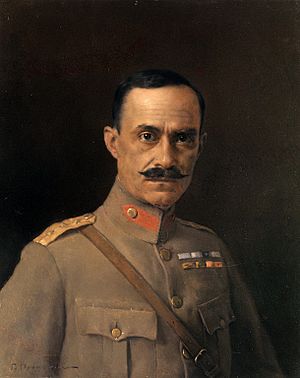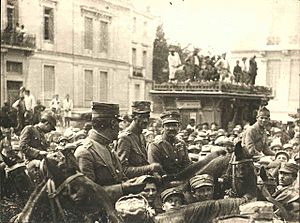Nikolaos Plastiras facts for kids
Quick facts for kids
Nikolaos Plastiras
|
|
|---|---|
| Νικόλαος Πλαστήρας | |
| Prime Minister of Greece | |
| In office 1 November 1951 – 11 October 1952 |
|
| Monarch | Paul |
| Preceded by | Sophoklis Venizelos |
| Succeeded by | Dimitrios Kiousopoulos |
| In office 15 April 1950 – 21 August 1950 |
|
| Monarch | Paul |
| Preceded by | Sophoklis Venizelos |
| Succeeded by | Sophoklis Venizelos |
| In office 3 January 1945 – 9 April 1945 |
|
| Monarch | George II |
| Preceded by | George Papandreou |
| Succeeded by | Petros Voulgaris |
| Personal details | |
| Born | 4 November 1883 Karditsa, Kingdom of Greece |
| Died | 26 July 1953 (aged 69) Athens, Kingdom of Greece |
| Political party | National Progressive Center Union |
| Signature |  |
| Nicknames | Black Rider Black Pepper |
| Military service | |
| Allegiance | |
| Branch/service | |
| Years of service | 1904–1924 |
| Rank | |
| Commands | 5/42 Evzone Regiment |
| Battles/wars | Macedonian Struggle Balkan Wars World War I
|
Nikolaos Plastiras (Greek: Νικόλαος Πλαστήρας; born November 4, 1883 – died July 26, 1953) was a famous Greek general and politician. He served as the Prime Minister of Greece three times. People knew him as "The Black Rider" because he was very brave during the Greco-Turkish War (1919-1922). He led a special army unit called the 5/42 Evzone Regiment.
After Greece lost the war, Plastiras and other officers started a revolution in September 1922. This led to King Constantine I of Greece being removed from power. The military government he was part of ruled until 1924. Then, power was given to an elected assembly, which created the Second Hellenic Republic. Later, Plastiras tried to prevent the monarchy from returning to Greece. He led two attempts to change the government in 1933 and 1935, but they both failed. This forced him to live in exile in France.
During World War II, when Greece was occupied by Axis forces, Plastiras was a leader of the EDES resistance group, even though he was still in France. After the war, he returned to Greece and became Prime Minister three times. He tried to bring peace and unity to Greek society after the Greek Civil War, but it was a very difficult task.
Contents
Early Life and Military Beginnings
Nikolaos Plastiras was born in 1883 in Karditsa, Greece. His family came from a village called Morfovouni in the mountains of Thessaly. The town of Plastiras is now named after him.
After finishing school, he joined the army as a volunteer in 1904. He fought in the Macedonian Struggle and was part of a military uprising in 1909. He became a second lieutenant in 1912 and fought bravely in the Balkan Wars. This is where he first got his nickname "The Black Rider."
Rising Through the Ranks
Plastiras became more widely known during World War I. He supported Eleftherios Venizelos, a major political leader. Plastiras fought well in battles, including the Battle of Skra-di-Legen, and was promoted to lieutenant colonel.
In 1919, he led the 5/42 Evzone Regiment in Ukraine. They were part of an Allied force helping the White Army against the Red Army. His unit then moved to Smyrna in Asia Minor. Even when the government in Greece changed, Plastiras was one of the few officers who kept his position. His soldiers were very loyal to him.
During the Greco-Turkish War (1919-1922), the Turks called Plastiras Kara Biber, meaning "The Black Pepper." His regiment was known as Şeytanın Askerleri, or "Satan's Army." After a major battle called Battle of the Sakarya, the Greek army had to retreat. Plastiras's unit fought bravely as they withdrew, even though they faced many challenges.
The 1922 Revolution
After the war, many soldiers were angry with the political leaders in Athens. This anger led to the 11 September 1922 Revolution. Plastiras, along with Colonel Stylianos Gonatas and Commander Phokas, led this revolution.
The revolutionary officers quickly took control of the country. Plastiras made King Constantine II step down. He also asked Eleftherios Venizelos to handle peace talks with Turkey, which led to the Treaty of Lausanne. The new government also reorganized the army.
One important and controversial action of the revolutionary government was the trial of several royalist politicians and a former general. They were found responsible for the Greek defeat in Asia Minor.
Plastiras faced many difficulties while leading Greece. Over a million refugees needed help, the economy was in ruins, and the country was divided. Despite these challenges, he helped bring order back to the country. He also helped set the stage for the Second Hellenic Republic. After new elections in December 1923, he left the army in January 1924. The National Assembly honored him for his service and gave him the rank of lieutenant general in retirement.
Even his opponent, Mustafa Kemal Atatürk, who founded modern Turkey, admired Plastiras. Atatürk once said that Plastiras was a very valuable leader.
Political Career and Later Life
The new Republic that Plastiras helped create was not very stable. There were many attempts to change the government, and constant disagreements between those who supported the Republic and those who wanted the monarchy back. Greece also faced ongoing economic problems.
Plastiras tried to lead a change in government in March 1933, but it failed. He was forced to leave Greece and live abroad. Later, after another failed attempt in 1935, he was sentenced to death while still in exile. However, he remained a respected war hero and a strong supporter of the Republic.
During his time in France, he saw Germany take over Greece in World War II. He later played a role in forming the EDES resistance group, which fought against the occupation.

Plastiras returned to Greece in 1945 and became Prime Minister. He tried to find a middle ground between different political groups. During his time as Prime Minister, the Varkiza Agreement was signed, which aimed to end fighting after the war. However, his moderate policies were not trusted by everyone, and he was removed from office after only three months.
In 1949, after the Greek Civil War ended, Plastiras started a new political party called the National Progressive Centre Union (EPEK). He spoke about bringing the country together and healing the divisions caused by the civil war.
He formed a government in 1950, but it did not last long. In 1951, his party became the strongest of the centrist parties. Plastiras formed another government and worked to help Greece recover economically and rebuild. A great example of his work is the construction of the Plastiras Dam on the Tavropos River, which created a large lake. Both the lake and the dam are now named after him.
His efforts to bring peace were often criticized. After losing the elections in November 1952, his political career ended. Nikolaos Plastiras died in Athens in 1953.
Images for kids
-
A statue in Karditsa
See also
 In Spanish: Nikolaos Plastiras para niños
In Spanish: Nikolaos Plastiras para niños





